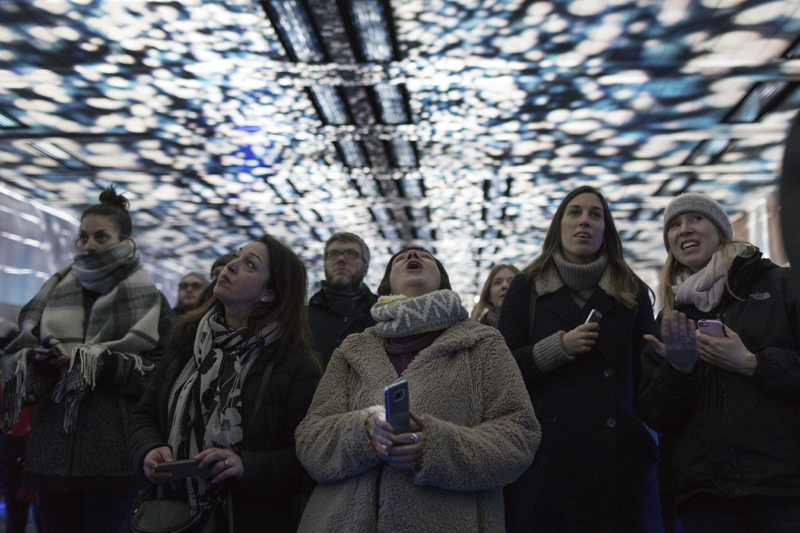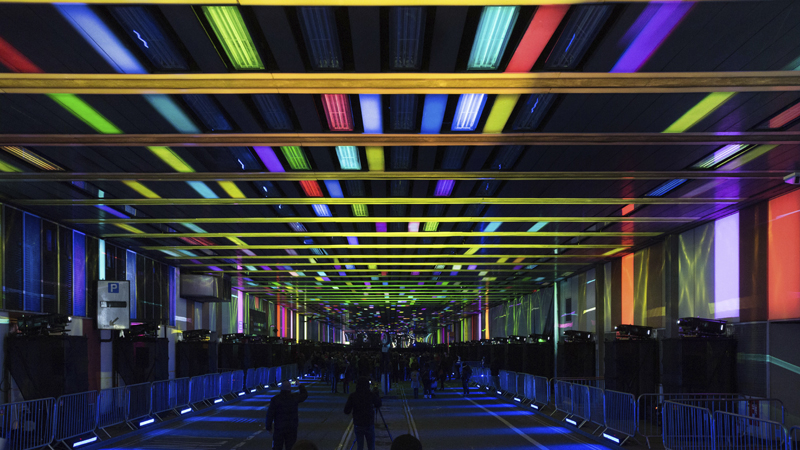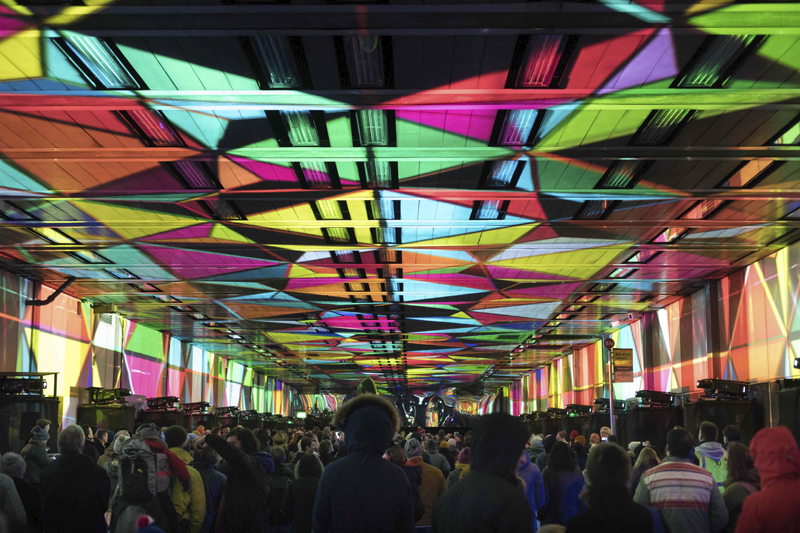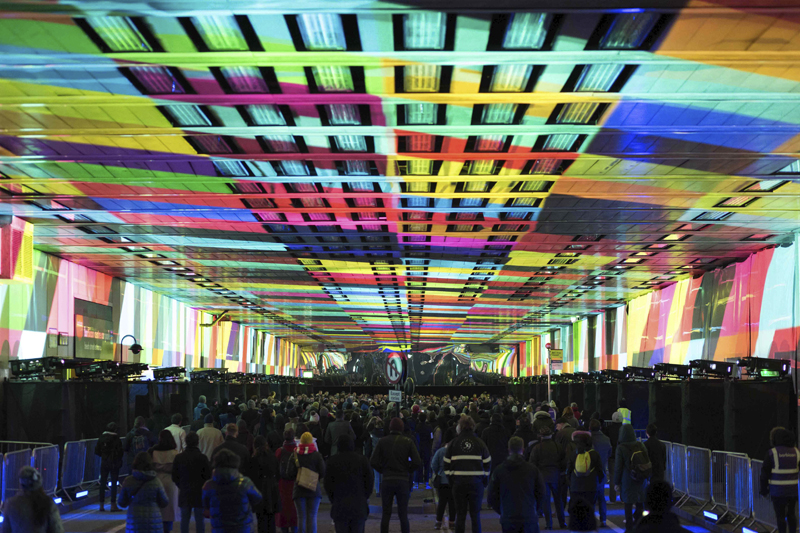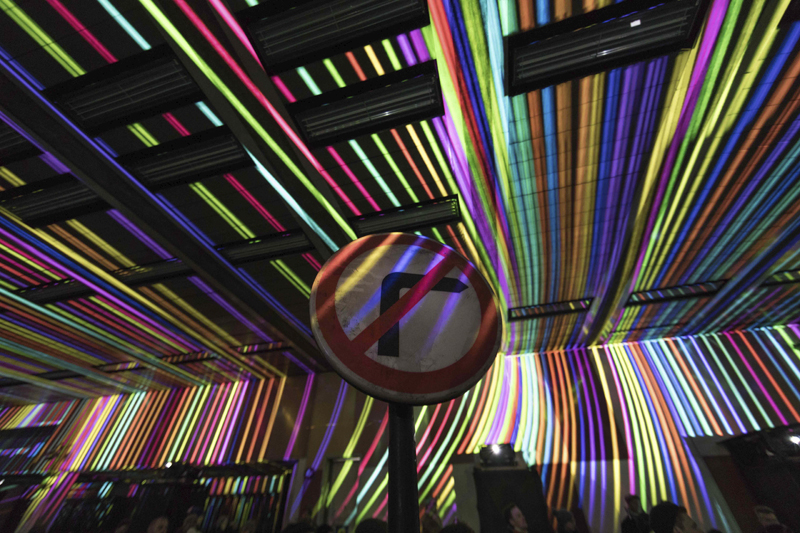This website uses cookies so that we can provide you with the best user experience possible. Cookie information is stored in your browser and performs functions such as recognising you when you return to our website and helping our team to understand which sections of the website you find most interesting and useful.
The Barbican – OpenFest
The multipurpose performance and experiential Barbican Centre venue’s OpenFest season saw a major new multimedia and sound installation by the Culture Mile partnership take place in the Beech Street tunnel, opposite Barbican Underground. Tunnel Visions: Array was an epic outdoor public artwork, created by 59 Productions led by director Richard Slaney and production manager Ollie Hester, and co-produced with the Barbican and City of London. Spanning the length of the Beech Street tunnel, this immersive audio-visual feast shut down a central London traffic artery in order to place audience members inside a piece of contemporary classical music and surround them with synchronized, video-mapped and animated graphical content, providing a multi-sensory full-orchestra experience up close and personal.
Using a specially recorded version of Esa-Pekka Salonen’s Karawane for Orchestra and Chorus, the experiential installation showcased the diverse sounds of the BBC Symphony Orchestra and Chorus using a unique sound design devised to play with the acoustic reflectivity of the tunnel.
Complementing the orchestral dynamics and arrangements, both walls and the ceiling of the tunnel became projection surfaces displaying swirling, evolving patterns of light, working with and against the music to play with perspective and visual tone. A free attraction, spanning the weekend, the show played multiple times throughout the day and evening to roaming audiences of several thousand.
Designed by Tony and Olivier Award-winning sound designer Gareth Fry, in conjunction with Robin Whittaker of UK spatial audio specialists OutBoard, the complex audio system featured a distributed “40.20” spatial audio system of individually fed Meyer UPJ speakers with 20 channels along each side of the tunnel mounted on towers which also housed the project’s 40 cross-firing video projectors. Every alternate tower also accommodated a single Meyer UMS sub bass cabinet, arranged in a zig zag pattern along the tunnel under every alternate tower.
This bespoke sound system topology required a versatile multichannel spatial audio matrix to manage it, so a TiMax SoundHub-S64 processor was specified to provide dynamic spatialisation, multitrack playback, system processing and fully-integrated showcontrol to sync everything together and help immerse the audience in the experience. Dual TiMax units were run as a redundant pair, feeding 60 channels of audio out to the speakers via a Dante audio network running to Yamaha RIO audio breakout interfaces out on the street. The redundant Dante audio network feeds from each TiMax went through an Autograph Dante switchover box for instant backup.
The BBC Symphony Orchestra and Chorus sources were provided as individual multitrack stems of each instrument and voice, which were loaded both into QLab theatre audio showcontrol software and also onto the TiMax SoundHub unit as alternative playback devices. A timecode reference signal was created to enable synchronization with multiple Disguise video servers which played back the visual content through the 40 projectors and mapped it onto the walls and ceiling of the tunnel
The audio content had been recorded live at a prior Barbican Centre concert, so most instrument and voice sources were subjected to significant sweetening using the input parametric EQs in TiMax, to help create a usable final mix of suitable quality, clarity and intelligibility on-site.
The music and voice tracks were pre-programmed with 3D spatial placements and panning movements in TiMax, triggered against timecode to sync them with the video material. Multichannel movements of instrument and voice sources along and across the channel were then fine-tuned and sequenced on-site as the final video edits were developed.
Richard Nowell Sound Services assembled and installed all of the sound equipment and audio networking, with on-site spatial audio programming support provided by Robin Whittaker of TiMax developers OutBoard.
The UPJ loudspeakers were installed actually facing the tunnel walls, firing into custom-designed acoustic reflectors that ensured a diffuse immersive soundfield rather than creating discrete audience-distracting hot-spots.
These speakers and the 20 sub-bass cabinets were programmed into individual spatial objects so that audio content, including low-frequency content, could be moved around in space using TiMax PanSpace spatialisation and scheduled using the TiMax TimeLine, which also synchronized spatial audio events to the visuals via timecode.
Using object-based spatialisation allowed diverse and flexible placement and movement of music and voice sources around the space, and using TimeLine scheduling allowed precise matching to visual events via timecode–related audio and showcontrol Cues in TiMax.
Presenting a dynamically moving immersive audio synced with video to a roving audience meant a conventional speaker system design could have deafened people nearby, and unraveled the immersivity as people moved nearer to individual speaker channels. Spreading the sound diffusively using reflectors was central to maintaining immersion for the whole audience, who were encouraged to move around and interact with the installation. Onboard TiMax output parametric EQ was invaluable for balancing out sonic artefacts caused by this slightly unusual speaker deployment.
The zig-zag sub-bass cabinet distribution pattern reduced cancellations and hence minimized low-frequency hot-spots and holes, and feeding them from individual TiMax signal channels meant that low-frequency content would be included in the object-based spatial audio movements. The diffuse and scattered nature of this sound design represented something of a first even for a complex TiMax spatial audio installation.
Audio playback was intended to be ultimately finally laid up on a QLab Mac from the TiMax internal SSD’s. During tech it was found necessary to roll-back and drop in frequently to facilitate video edits to be reviewed along with the timecode synchronized audio. The TiMax TimeLine could drop in and start at any point so it ended up becoming the default playback engine. The timecode sync signal was laid onto one audio track of the TiMax and split across the Disguise video servers to start and stop them on the fly and then run them during the shows.
A free event, this piece engaged a new audience with the work of both Esa Pekka Salonen and the BBC Symphony Orchestra. The first time that the Beech Street tunnel has been closed for such an experience, the project set a new bar for immersive multimedia art, transforming an unloved thoroughfare in to an audio-visual performance space. The found-space nature of the venue and audience space necessitated a ground-up approach to the combined sonic and visual designs, therefore innovative techniques, elements and processes were demanded for the audio system implementation, content management, spatial rendering and showcontrol integration between the various media – often being adapted on the fly as circumstances dictated.
Director, 59 Productions’ Richard Slaney, sums up, “TiMax created a fantastic audio experience for the thousands of patrons that visited Array during this year’s OpenFest, enabling the audience to fully immerse themselves in this unique, specially commissioned recording of Esa-Pekka Salonen’s Karawane. The resultant audio output was truly breath-taking, which made for an extraordinary audio experience that really placed the audience within sound world of the BBC Symphony Orchestra and Chorus.”
